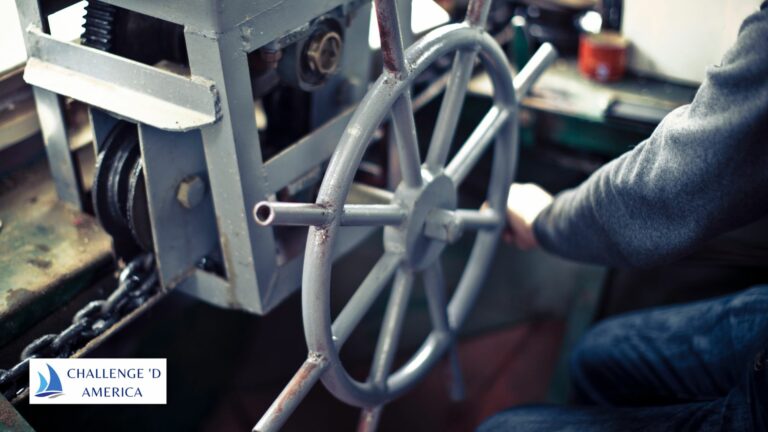What Are Some Safety Tips To Follow While Sailing In Rough Weather?
As an experienced sailor, I know that sailing in rough weather can be an exciting and potentially rewarding experience. But, I also know that safety should always be the top priority when venturing out in choppy waters.
While no sailor can guarantee a 100% safe voyage, there are certain safety tips that should be implemented before, during, and after rough weather sailing trips.
In this article, I’ll be breaking down my top safety tips to follow when sailing in rough waters. From preparing the right gear to being mindful of the weather — get ready to set sail with confidence!
Safety Tips For Rough Weather Sailing
The following are some safety tips that should be followed while sailing in rough weather:
- Before sailing, check the wind and wave forecasts, and be sure to plan your sail accordingly. Pay special attention to any expected squalls or thunderstorms, and be sure to stay in port if necessary.
- Always wear a life jacket or personal flotation device (PFD).
- Pay attention to the weather conditions and reduce sail if necessary. If it starts to get too windy or too rough, consider seeking shelter or turning around and heading back to port.
- Secure all loose items on the boat, including sails, oars, lines, and personal belongings.
- If necessary, reef the sails or reduce the amount of sail being used.
- When in doubt, don’t go out. If you are unsure of the local weather or sea conditions, it’s best to remain in port until more information can be gathered.
- If you do find yourself in rough weather, avoid jibing or tacking, as these maneuvers can cause the boat to heel over and place undue stress on the rig.
- When sailing in rough seas, it is important to be prepared for a capsize or man overboard situation. Have a plan in place for such an event and make sure all crew members are aware of it.
- Always carry a marine VHF radio and stay in communication with other vessels and the coast guard.
- Lastly, remain vigilant at all times and use common sense. If it looks like it’s getting too dangerous, head to the nearest port.
A. Staying Alert
When sailing in rough weather it is important to remain alert and aware of your surroundings at all times. One of the best ways to stay alert is to monitor the weather and sea conditions regularly.
Before setting off, check local forecasts and be aware of any potential weather systems that may be coming your way. Once on the water, keep a radar watch and be aware of any potential changes in the conditions.
You should also pay attention to the wind direction and speed. Changes in the wind can be an indication of approaching bad weather and it is important to adjust your sail plan accordingly. Make sure to stay aware of any squalls and their location, as well as any other vessels in the vicinity.
It is also important to monitor changing sea states. Keep an eye out for changes in the wave direction, size and frequency as these can be a sign of an approaching storm. Additionally, be aware of the barometric pressure as a rapid drop in pressure can indicate a storm is incoming.
Finally, stay on your toes and remain vigilant. If at any time you feel unsafe or uncomfortable, the best option is to head to shore or a safe harbor.
B. Wearing The Right Clothing
For those planning to sail in rough weather, it is essential that the appropriate clothing and protective gear is worn. This includes a wetsuit, buoyancy aid (or lifejacket), deck boots, waterproof clothing and a hat or hood.
A wetsuit helps to insulate and protect the sailor in cold weather, whilst the buoyancy aid helps to keep the sailor afloat should they go overboard. Deck boots are designed to have a non-slip sole, providing better grip on wet surfaces.
Waterproof clothing is essential to keep the sailor dry in wet conditions and a hat or hood helps protect from the wind and rain.
In addition, sailors are advised to wear a tether or harness attached to the boat at all times. This is particularly important in rough weather, as the winds can be strong and the waves big. Wearing a tether can help protect the sailor from being swept overboard.
C. Securing The Boat
Once the decision has been made to sail in rough weather, it is essential that the boat is properly secured. It is important to ensure the boat is well-balanced and the sail is flattened to reduce water resistance.
Use a preventer to control the boom and secure any loose items. Make sure the running rigging is securely fastened, and the halyards on the mast are cleated tightly. All lines should be run through the proper blocks and fairleads, and the boom should be secured with a boom-vang.
Ensure the cleats and chocks are strong and secure. Spreader brackets should be checked for corrosion, and the stays should be tuned to a correct tension. Additionally, the rudder and its seals should be checked for any cracks or damage.
Before leaving port, ensure all deck hardware is securely fastened, including the stanchions, blocks, genoa tracks, and the winches. Check the mast and its attachments, and make sure the anchor is securely stowed.
It is important to also check the bilge pumps to ensure they are working properly. Finally, double check all the running rigging, and ensure that all the sails are properly stowed.
Taking the time to secure the boat is essential to ensure a safe and enjoyable time sailing in rough weather.
D. Staying In Control
When sailing in rough weather, it’s important to stay in control at all times and ensure that the vessel is stable and secure. To maintain control and stay safe, it’s best to maintain a reef in the sails and reduce canvas where appropriate.
Heaving-to or lying ahull can be a viable option for experienced sailors, as this allows the boat to remain steady and secure without losing too much ground.
In addition, it’s important to keep an eye on the wind direction and adjust course accordingly, as well as adjusting sail trim as needed.
It’s also a good idea to double up on safety equipment, such as jib sheets, mainsheet, and halyards, to ensure continued control in the event of a breakage. Lastly, it’s important to monitor the boat’s speed and remain aware of the conditions around you, making sure to reduce speed in particularly challenging weather.
E. Knowing When To Turn Back
One of the most important safety tips to follow while sailing in rough weather is to know when to turn back. Understanding when your vessel is no longer able to safely handle the elements is key.
If conditions worsen or you find yourself in a situation you are uncomfortable with, it is always best to turn back and seek shelter.
A good rule of thumb is to plan for the worst and be prepared to turn back if conditions exceed the capabilities of your vessel or crew. Make sure to evaluate and monitor the weather forecast and sea state before departing, and be aware of any sudden changes in wind speed or direction.
Additionally, always carry a Marine VHF radio on board and be able to check in with your local weather station for real-time updates of the current sea conditions.
It is also essential to know your personal limitations and capabilities. If you are unsure about a situation, it is best practice to err on the side of caution and turn back.
Experienced sailors will also know when to reef the sails as a means of controlling the vessel in rough weather conditions and minimize the risk of capsize.
If you find yourself having to turn back in rough weather, it is important that you are familiar with your boats sailing systems and have an understanding of the manoeuvres required to safely return to a safe harbour.
Make sure that you have checked the running rigging, windward sheet, and any other controls needed to successfully operate the boat in rough conditions.
By following these tips and knowing when to turn back, sailors will be better informed on how to
F. Maintaining Communication
It is essential to maintain communication when sailing in rough weather. Keep up-to-date with the latest weather reports and communicate any changes in the conditions with the rest of the crew.
Make sure to maintain a VHF radio in good working order, as this is the primary means of communication in the event of an emergency.
It is also a good idea to equip each crew member with a hand-held VHF radio in case the main VHF fails. Ensure that a satellite phone is available, as this will provide a backup means of communication in case of an emergency.
Always maintain a logbook and voyage plan and update it regularly to alert people of any changes in the voyage.
G. Keeping An Eye On The Weather
One of the most important safety tips while sailing in rough weather is to keep an eye on the weather conditions. As a sailor, it is important to be informed of the forecasted weather, wind strength and direction in order to plan your voyage accordingly.
The best way to do this is to use weather forecasting services such as NOAA’s National Weather Service which can provide detailed information on the current and expected weather conditions in the area.
Additionally, it is helpful to install a weather station on board the vessel in order to stay informed of the current weather conditions at any given time. This can also be used to take proactive measures to avoid extreme weather conditions.
Furthermore, it is beneficial to have a reliable VHF radio onboard to stay in communication with other vessels in the area. This will allow for the exchange of information about the current weather and seas, allowing for more informed decisions when it comes to sailing in rough weather.
Summary: What Are Some Safety Tips To Follow While Sailing In Rough Weather?
As a sailing expert, I would advise that sailors should take extra caution when sailing in rough weather. It’s important to check the weather forecast before embarking on the voyage, as well as to ensure that the vessel is equipped with the necessary safety gear.
Before setting sail, it’s important to understand the local wind patterns and waves, as this will help inform the sailing strategy. When aboard, sailors should monitor the situation constantly and be prepared to adjust course as needed.
Finally, it’s always best to wear a life jacket and to keep a lookout for any other vessels in the vicinity. By following these rules, sailors can ensure that their journey is as safe and efficient as possible.
FAQs
What Type Of Safety Equipment Should Be On Board When Sailing In Rough Weather?
When sailing in rough weather, it is important to ensure that you have the necessary safety equipment onboard. This includes personal flotation devices for each person on board, a waterproof flashlight and a VHF radio.
You should also carry a first aid kit, a whistle, a signal flag and a handheld GPS in case of emergency. To meet maritime safety requirements, you should have flares, a compass, a bilge pump and a fire extinguisher on board.
It is also essential to have a working anchor and enough line to secure the boat in case of emergency. Additionally, if your boat is fitted with rails, it is advisable to have additional lifelines for crew members.
Finally, make sure you have an emergency tiller and a marine-grade rope ladder in case of abandonment. This equipment should be regularly checked and maintained to ensure it is in good working order.
What Type Of Clothing Should Be Worn When Sailing In Rough Weather?
When sailing in rough weather, it is important to wear the appropriate clothing that will keep you warm, dry, and safe. The best type of clothing to wear is a waterproof layer such as a wetsuit or drysuit.
The wetsuit should be thick enough to keep you warm in cold temperatures, and the drysuit should be breathable and waterproof to help keep you dry. Additionally, you should wear boots with a non-slip sole, a hooded jacket, and a life jacket.
It is also a good idea to wear a hat, gloves, and a scarf to protect you from the elements. If you have sunglasses, it is a good idea to wear them to protect your eyes from the sun and wind. Lastly, consider wearing a buoyancy aid to help keep you afloat if you fall overboard.
What Type Of Communication Should Be Used When Sailing In Rough Weather?
When sailing in rough weather, it is extremely important to use proper communication. In these conditions, communication should be direct and informative. The skipper should be in charge of communications, and should give out clear instructions to the crew.
It is best to communicate using radios or other verbal means of communication in these conditions, as it is easier to be heard and understood over the noise of wind and waves.
Having a clear plan of action is essential in these conditions. The skipper should communicate the plan to the crew, detailing what the boat’s course should be and how the crew should position themselves onboard. For example, crew members will need to be allocated to specific tasks, such as reefing and trimming sails.
In addition to verbal communication, hand signals can be used to communicate between the skipper and crew. This can help to ensure that everyone is aware of what needs to be done, and can help to prevent mistakes in a dangerous and unpredictable situation.
Finally, communication should be used to check on everyone’s wellbeing. The skipper should ask the crew if they are feeling safe and secure during the storm, and should be open to changing plans if crew members are feeling uncomfortable.
Overall, when sailing in rough weather, communication should be direct, informative and frequent. This will help to ensure everyone onboard is aware of the plan, and can help to prevent mistakes in dangerous conditions.
What Type Of Navigation Should Be Used When Sailing In Rough Weather?
When sailing in rough weather, it is important to use the appropriate navigation techniques. Piloting is the best type of navigation to use in rough weather.
Piloting is the practice of navigating a vessel in a given area by taking bearings of landmarks and other navigational aids. This allows a skipper to determine their position and adjust their course accordingly.
Piloting also includes taking soundings and tidal observations to determine the depth of the water and the direction of the currents.
Piloting should be done by an experienced sailor who is familiar with the area and understands the effects of the weather on navigation.
In addition to piloting, using a chart is important for navigation in rough weather. A chart is a detailed map of a given area that shows depths, hazards, land features, and other important navigational information.
It is important to check the chart often and to use tools such as a compass and a sextant to accurately determine the vessel’s position. In addition, a GPS can also be used as a navigational aid in rough weather.
Finally, it is important to ensure that the vessel is equipped with the necessary navigational equipment, such as a compass, sextant, and GPS, as well as a good supply of charts. Using these navigational tools, along with piloting, will ensure that a vessel is able to safely navigate in rough weather.
What Type Of Weather Conditions Should Be Avoided When Sailing In Rough Weather?
When sailing in rough weather, it is extremely important to be aware of the weather conditions and avoid any dangerous weather.
The best way to stay safe is to avoid sailing in high winds, heavy rain or lightning storms, or in any conditions where visibility is poor.
High winds can be very dangerous as they can cause a boat to capsize and make it difficult to control the sails. In these conditions, it is important to reef the sails and reduce the sail area. If the wind is too strong, it is best to stay in port and wait until the wind drops before going out to sea.
Heavy rain can also be dangerous as it can reduce visibility, making it difficult to see any other vessels or obstacles in the water. It can also put extra strain on the boat and sails, so it is important to check all the lines and rigging before heading out.
Lightning storms can be particularly dangerous when sailing as boats are at risk of being struck by lightning. If you see lightning or hear thunder, the best thing to do is to get to a safe harbour as soon as possible.
In any conditions where visibility is poor, it is important to take extra care and slow down. This can reduce the risk of a collision with other vessels or obstacles. It is also important to ensure that all the navigation lights are on so that other vessels can see you in the dark.
By following these tips, you can make sure that your sailing trip is safe and enjoyable, even in rough weather.







